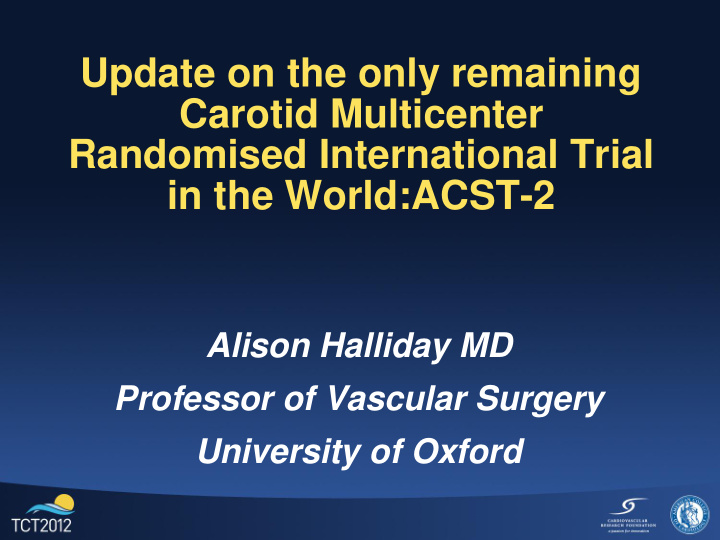



Update on the only remaining Carotid Multicenter Randomised International Trial in the World:ACST-2 Alison Halliday MD Professor of Vascular Surgery University of Oxford
Disclosure Statement of Financial Interest I, Alison Halliday, DO NOT have a financial interest/arrangement or affiliation with one or more organizations that could be perceived as a real or apparent conflict of interest in the context of the subject of this presentation.
ACST-2 is funded by and organised within
Projected Rise in Stroke Mortality Worldwide to 2030 (WHO)
Symptomatic or Asymptomatic?
ACST-1 (1993-2008) Tight asymptomatic carotid stenosis 3120 patients 1560 1560 medical treatment medical treatment alone +CEA CEA reduced subsequent stroke risk by ~50% Benefit maintained to 10 years
Surgery for men & women under 75 years reduces 10-year stroke risk (c) Any type of stroke or perioperative death (a) Any type of stroke or perioperative death (Female, Age <75) (Male, Age <75) 18.1% % 20 % 20 Gain at 16.0% Gain at 5 yr: 2.5% (1.9), p > 0.1; NS 5 yr: 6.5% (1.5), p = 0.00001 Deferred 10 yr: 5.8% (2.9), p = 0.05 10 yr: 5.5% (2.3), p = 0.02 Deferred Absolute risk of Stroke 12.3% Immediate 8.4% by 6% Immediate 10 12.7% 10 10.2% 5.9% 5.8% 0 Years 0 0 5 10 Years 0 5 10 Perioperative + other events Perioperative + other events Years 0-4 Years 5+ Years 0-4 Years 5+ 16 + 7 0 + 9 Immediate 4 + 28 1 + 17 Deferred 17 + 28 0 + 25 Immediate 8 + 84 1 + 21 Deferred
Lipid-lowering treatment at randomisation & during follow up Lipid-lowering Drugs use during ACST We analysed effects of this On overall result
Same absolute benefit from surgery (6% in stroke risk) for patients on statins
ACST-1 – peri-operative risk may be reduced by statin therapy ACST-1 4.3% 2.2%
>250,000 Carotid Interventions Worldwide but Wide Variation in Practice Asymptomatic Proportion Stented (%) (%) US 90 40 Europe 60 40 UK 20 10 Means much Uncertainty about choosing CEA or CAS
The Rationale for ACST-2 In large asymptomatic carotid stenting registries, in CREST, and in ACST-1 the hazard of intervention is ~3% Hazards of CEA and stenting may be similar, but long-term benefits are not yet known 4832 US patients. Circ Cardiovasc Intervent 2009; 2: 159
Worldwide during the 2010s, millions of asymptomatic patients will have carotid stenting or surgery ACST-2 hopes to randomise up to 5000 people to reliably assess the early and long- term efficacy of carotid stenting vs endarterectomy
When intervention seems clearly needed and both procedures are appropriate Consider patients for ACST-2 Stenting Surgery
Begin the randomisation process in the Vascular Lab Wall Posters Stickers for Doppler scan reports/notes
Characteristics of first 1000 patients in ACST-2 Median age 71 ( 68*) 70-99% stenosis 96% 70-100% contralateral stenosis 20% Diabetic 30% (20*) Renal Failure 11% Atrial Fibrillation 6% Ischaemic Heart disease 37% (* ACST-1)
Medical Treatment at Trial Entry • Anti-thrombotic 90% • Anti-hypertensive 79% • Lipid-lowering 75%* *Higher usage expected in follow-up
ACST-2: blinded early results 691 patients (1 month follow up + 6-month Rankin scoring for any stroke) CEA (348) CAS (343) Mostly aspirin Dual anti-platelet Patch 50% 8 types of stents Shunt 29% Most with CPD GA 56% GA 6%
Straight (54%) Tapered (46%)
CEA CAS
30-day overall morbidity (691 pts) Death / disabling stroke 1.0 (7) * Non-disabling stroke 2.0% (14) Non-fatal MI 0.4% (3) * ACST-1 1.7 % ( for CEA)
Data Monitoring Committee (2012) Chair, Professor P Sandercock The DMC had no concerns and saw no reason to modify the protocol or intake to the study The DMC commends the investigators on progress to date, and on the recent increase in recruitment We urge the ACST-2 group now substantially to increase the rate of patient recruitment while maintaining close long- term follow-up of all cases in this important trial. (next review April 2013)
Final UK NICE guidance on carotid stenting for asymptomatic carotid stenosis “ NICE encourages clinicians either to enter patients into the ACST-2 trial or to submit data to the Endovascular Carotid Register” 27 April 2011 NICE (UK National Institute for Clinical Excellence)
ACST-2: simple & efficient (clinicians do it for love, not money) Randomise online Only 2 x 1-page forms to complete £100 per patient recruited with follow- up to 1-month completed Email us at: acst@nds.ox.ac.uk Website: acst.org.uk
Asymptomatic Carotid Surgery Trial-2 Collaborators’ Meeting, Oxford April 2013
Recommend
More recommend